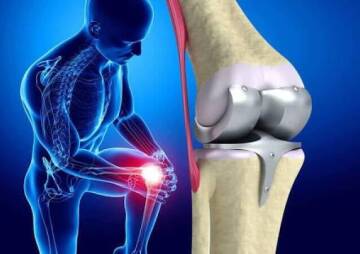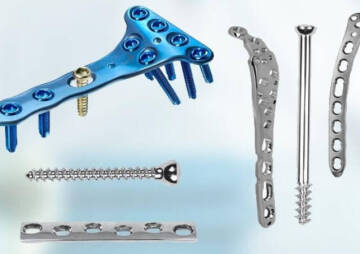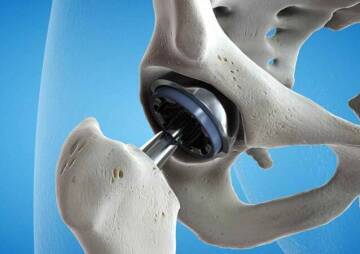-
Category
Craniomaxillofacial Surgery
Orthopedic Surgery
Spine Surgery
Orthopedic Implants
Hip Surgery
Knee Surgery
Pectus Excavatum
Bone Graft
Disinfectants
Healthcare
Critical Facts about Orthopedic Surgeries

Orthopedic surgery is concerned with conditions that are involved with musculoskeletal system and for treating this, the surgeons use both surgical and non-surgical means. The developments in the orthopedic surgery root in the experience from the wartime.
Orthopedic surgery is concerned with conditions that are involved with musculoskeletal system and for treating this, the surgeons use both surgical and non-surgical means. The developments in the orthopedic surgery root in the experience from the wartime. In the early ages, the orthopedics meant only correcting the deformities in the children. With the passing of years, new methods came, the technology developed, and now there are many types of orthopedic surgeries, which are performed by the respective orthopedics.
- Total Joint Replacement This is a surgical process, where certain parts of the joint, which are damaged or arthritic, are removed and replaced with artificial joints that perform the same function in the same healthy and flexible manner.
- Knee Replacement Total knee replacement surgery is a good option for people who have severe arthritis. During the replacement surgery, the knee cartilage is replaced with an implant.
- Total Hip Replacement In this process the ball and socket joint that are effected with arthritis are removed and new ball and socket joint is replaced instead, which allows the joint to move freely.
- Shoulder Replacement In order to improve the motion and the movement in the shoulder, the damaged bone and the cartilage is replaced with an implant.
- Rotator Cuff Repair It helps the shoulder to move and keeps it anchored. A slight tear in the cuff can be painful and limit the movement of the individual. The tears can only be repaired with the help of the surgery, and can improve the strength back.
- Spine Surgery Spine surgery is to improve the movement and eliminate the pain. This surgery is done only after the non-surgical methods fail to ease the pain. Spine surgery is the ultimate pain-killing method, but it holds its risks and dangers. Plus, it is done right near the spinal cord of the patient.
- Ankle Surgery A variety of problems are related to ankles and wrists which require surgical treatment. If conservative methods fail, then in cases of stress fracture, arthritis, and injuries, the surgery is performed.
- Anterior Cruciate Ligament ACL is the major ligament of the knees and when it is ruptured, the reconstruction can be done in a few ways. State of the art tendon graft is one of them.
Spine Fusion
Spinal fusion, popularly known as spondylodesis or spondylosyndesis, is an orthopedic or neurosurgical technique. This technique joints two or more vertebrae together and it can be performed at any level in the spinal cord, such as lumber, thoracic, and cervical. This process prevents movements between the vertebrae that are fused together. The most common reason that the spinal cord is under pressure is the degenerative disk disease. Other cases, where the spinal fusion can be considered, are spinal disk herniation, tumor in the spine, scoliosis, spondylosis, fracture in the vertebrae, and any other condition that will cause instability to the spinal cord.
ACL Reconstruction Surgery
This is an injury which happens in the knees. Here, the injury is in a form of a tear or sprain of the anterior cruciate ligament that is the major ligament in the knees. This injury is most common in the sport types that involve sudden changes in the direction and stops, including jumping and landing. A few of these sports are football, basketball, and skiing. The treatment of the ACL depends on the severity of the injury. Here, the surgeon removes the torn ligament and a piece of tendon is replaced from another part of the patients’ knee, or from an external donor. The surgery is done by making small incisions around the knee joint.
Knee Arthroscopy
Knee arthroscopy is a technique where the surgeon makes a small incision and inserts a camera, which is called arthroscope, into the knee of the patient to see the inside part of the knee and the joint. This process allows the surgeons to investigate and find the issue and correct the problem using small instruments within the arthroscope itself. It diagnoses many knee problems, such as torn meniscus, as well as misaligned patella.
Shoulder Arthroscopy
Same like the knee arthroscopy, the shoulder replacement surgery also uses tiny cameras to examine and repair the tissues located inside or around the shoulder joints. During the surgery, all the tissues are inspected and examined by the surgeon. Cartilage, bones, tendons, and ligaments are included in the tissues. There might be a need to do an open surgery, if the surgeon learns that there is a serious damage caused.
Arthroscopy Surgery
The process of arthroscopy is merely opening a small incision and examining the inner part of the joints through a camera. There is no need for a big incision in this type of surgery, but if there is a damage caused inside that cannot be treated with the help of arthroscopy, then a bigger incision is made and the damage is treated. The advantage over the traditional methods is that the surgeon does not need to fully open up the joints. Small incisions mean that the recovery time will be less too, and the patient does not need to worry about the marks of the stitches being left back on the surface of the skin.
Spinal Surgery
The pain in the lower back can be treated without surgery. There are non-surgical processes as well that help to soothe the pain. However, surgery is the last option when these non-surgical methods fail to calm the pain and the patient still complains about back pain. The spine surgery happens in the case of a tumor in the spinal cord, ruptured or herniated disk , and spondylolisthesis, which is when the bones of the spine slip out of their respective place, and other conditions.
Some common types of back surgery are vertebroplasty and kypohplasty, spinal decompression, discectomy, foraminotomy, plasma disk decompression which is called nucleoplasty too, spinal fusion, and the artificial replacement of the disk.
Back surgery being performed near the spinal cord, holds greater risks than other surgeries. The incisions which are made for the surgery are done from front, back, and sides, to reach the spinal cord of the patient. As we know, the incisions which are made from the sides are safer than the ones from the front and back. The recovery time is longer in the case of spine surgery as it is done in the crucial area, and since it is an open surgery, the wounds take time to heal.
Joint Fusion
The doctors suggest joint fusion to patients who are having severe arthritis pain. In this process, two bones are fused together into one solid bone to decrease the pain. The incisions are then closed with the help of sutures. Joint fusion surgery can be done in joints such as spine, ankles, wrists, fingers, and feet.
Debridement
For treating a wound in the skin, the procedure of debridement is done. This process involves cleaning the wound and removing the hyperkeratotic, infected, and the tissues which are necrotic from it. For treating diabetic foot ulcers, this is the most essential step, and it occurs in at least 15% of the patients. Debridement can be done either surgically or in alternative methods with the help of the special dressings and gels. The advantages of this process are that it removes the dead skin, allows the healthy skin and tissues to heal, and eliminates conditions that lead to pain and amputation eventually.
Trigger Finger Release
Trigger finger release is also known as stenosing tenosynovitis. The pain of trigger finger is like having a finger or a thumb stuck in a curled manner. The pain is there whether the hands are being used or not. Adding to the pain, there comes the frustration in the patient as they cannot do the things they want to, like buttoning the clothes, texting, or even playing the guitar. The trigger finger release surgery is safe one, but it does contain complications like damage to the nerves, incomplete extension, and bowstringing.
Revision Joint Surgery
As the name suggests, the revision joint is done to replace the worn out joint. This process is also called “revision arthroplasty.” People often undergo this surgery as repeat replacement of joint. The revision replacement can be performed many times as there is no limit to it, but it gets difficult each time it is performed.
Bone Fracture Repair
In this type of surgery, the surgeon makes the incisions over the fractured area. This repairing process is done when the bone does not heal properly with splinting alone. Bone graft is recommended when the bone is shattered into the fragments during the injury. The process uses bones from different parts of the body or from an external donor. After setting the broken bone properly, the incision is closed with stitches and the area of the incisions are cleaned appropriately .
Soft Tissue Repair
After any type of injury, the soft tissues in the body begin a natural healing. The time span for the healing process varies from injury to injury and person to person. Age plays an important role here as well. The main risk of future injuries caused to the individual depends highly on how the soft tissue were rehabbed and recovered. The soft tissue healing is also defined as the replacement of the destroyed tissue by the living tissue, which is present in the body. This process consists of two parts, namely, regeneration and repair.
Hip Replacement Surgery
In hip replacement surgery, the surgeon removes the painful hip joint and replaces it with an artificial one, often made from metal or plastic components. It is done only when the non-surgical methods fail to relieve the pain and in order to allow the patient to walk and move freely without any pain. During the surgery, the patient is given general anesthesia in order to relax the muscle and he is put to sleep. After the surgery, the patient is bound to stay in the hospital for maximum six days. A tube will be connected to the bladder in order to help the patient in going to the bathroom. Physical therapy is advised to be taken the day after the surgery, and a walker is used in order to allow the patient to walk. It must be noted that even if the hip joint has recovered, there are still certain sports and activities that must be avoided by the patient on advice of the therapist.
Ankle Repair
The process of ankle repair is usually done under general anesthesia. The incision is made outside the ankle and then ankle arthroscopy is performed to check the level of the injury in the area. In the cases of torn and stretched ligament, they are stitched and reattached properly as needed. After the process, the patient may leave the hospital and go home, but they will not be able to bear weight on the foot for 10 to 14 days and might need a walker to help with walking.
Osteotomy
This is a surgery in which the bones are cut and reshaped. Such surgery is done to repair a joint that is damaged. Osteotomy can fix problems in many joints, like the ones in the hip, knee, spine, jaw, big toe, and the chin. The doctor will make a small incision and will use special wires that will guide and measure the bones, and then take out a part of it with the help of a surgical saw. Later, tiny orthopedic screws and plates are used to hold the bones in their places and the open spaces are filled. Depending on the type of the surgery, the patient may have to stay for a few days in the hospital.
A thorough and detailed knowledge about all types of surgeries is given above. Want to get more answers for your questions in the same area? You will find them on our website with a simple search!
References : allegraortho, ncspecialty, healthline, webmd






